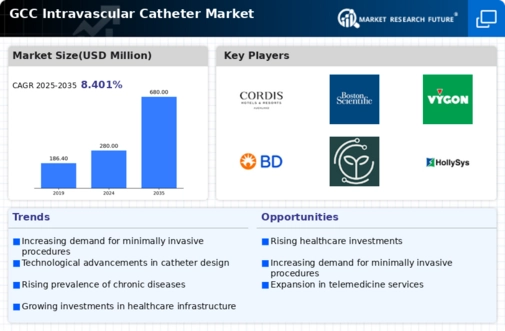Rising Geriatric Population
The growing geriatric population in the GCC region is a crucial factor influencing the intravascular catheter market. As the elderly population increases, there is a corresponding rise in the prevalence of age-related health issues, necessitating more frequent medical interventions. The World Health Organization estimates that the number of individuals aged 60 and above in the GCC will double by 2030, leading to a higher demand for medical devices, including intravascular catheters. This demographic shift suggests that healthcare systems will need to adapt to the needs of older patients, thereby driving the market for intravascular catheters as essential tools for effective treatment.
Expansion of Healthcare Infrastructure
The ongoing enhancement of healthcare infrastructure across the GCC countries significantly influences the intravascular catheter market. Governments are investing heavily in modernizing hospitals and clinics, which includes the procurement of advanced medical devices. For instance, the GCC healthcare expenditure is projected to reach $104 billion by 2025, reflecting a commitment to improving patient care. This expansion not only increases the availability of intravascular catheters but also promotes the adoption of innovative technologies. As healthcare facilities upgrade their capabilities, the demand for high-quality intravascular catheters is likely to rise, thereby driving market growth.
Growing Awareness of Infection Control
There is an increasing emphasis on infection control and prevention in healthcare settings within the GCC, which serves as a significant driver for the intravascular catheter market. Healthcare professionals are becoming more aware of the risks associated with catheter-related infections, leading to a demand for safer and more effective catheter designs. The introduction of antimicrobial-coated catheters and other innovations aims to reduce infection rates, which can be as high as 30% in some cases. This heightened focus on patient safety and quality of care is likely to propel the market for intravascular catheters, as healthcare providers seek to implement best practices in infection management.
Increasing Prevalence of Chronic Diseases
The rising incidence of chronic diseases such as diabetes, cardiovascular disorders, and cancer in the GCC region is a primary driver for the intravascular catheter market. As healthcare providers seek effective solutions for managing these conditions, the demand for intravascular catheters is likely to increase. According to recent health statistics, chronic diseases account for approximately 70% of all deaths in the GCC, necessitating advanced medical interventions. This trend indicates a growing need for reliable and efficient catheterization techniques, which are essential for various diagnostic and therapeutic procedures. Consequently, the intravascular catheter market is expected to expand as healthcare systems adapt to the increasing burden of chronic illnesses.
Technological Innovations in Catheter Design
Technological advancements in catheter design and materials are transforming the intravascular catheter market. Innovations such as biocompatible materials, advanced coatings, and smart catheters equipped with sensors are enhancing the functionality and safety of these devices. The market is witnessing a shift towards products that offer improved patient outcomes, such as reduced thrombosis and enhanced ease of use. As healthcare providers increasingly prioritize the integration of cutting-edge technology into their practices, the demand for these advanced intravascular catheters is expected to grow. This trend indicates a dynamic evolution within the market, driven by the need for enhanced performance and patient care.

















Leave a Comment